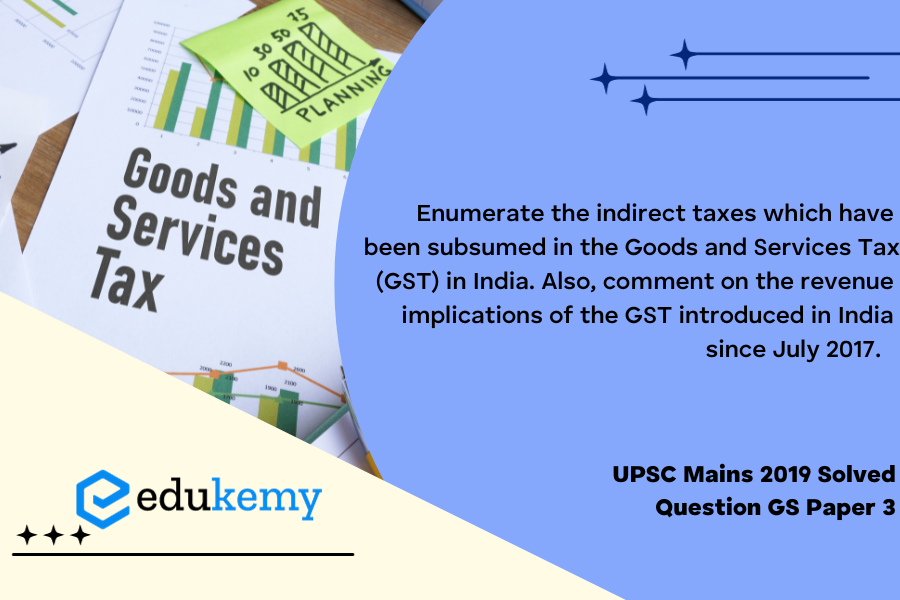The implementation of the Goods and Services Tax (GST) in India in July 2017 marked a significant shift in the country’s taxation system by subsuming various indirect taxes under a unified framework. The indirect taxes that were replaced by GST include Central Excise Duty, Service Tax, Additional Customs Duty, Central Sales Tax, Value Added Tax (VAT), and various surcharges and cesses. This consolidation aimed to streamline the taxation structure, eliminate cascading effects, and create a more transparent and efficient tax regime. The GST has had notable implications on government revenue, offering a simplified tax structure that promotes ease of compliance. However, the initial transitional challenges and adjustments faced by businesses, coupled with periodic revisions in tax rates, have influenced the revenue dynamics. Despite these challenges, GST has contributed to a more integrated and uniform tax system, fostering economic growth and enhancing the ease of doing business in India.
Tag: Indian economy and issues related to planning, mobilization of resources, growth development and employment. Government budgeting.
Contents
- 1 Decoding the Question:
- 2 Answer:
- 2.1 Central Taxes subsumed under GST:
- 2.2 At the State level, the following taxes are being subsumed:
- 2.3 Central Taxes not subsumed under GST:
- 2.4 State Taxes not subsumed under GST: State Excise on liquor production and some other taxes.
- 2.5 Positive Implications on Revenue:
- 2.6 Negative Implications on Revenue:
- 3 In case you still have your doubts, contact us on 9811333901.
Decoding the Question:
- In the Introduction, try to write about Goods and Services Tax (GST) in brief.
- In Body,
- First, enlist the indirect taxes (both under the Centre and State) that have been subsumed under GST.
- Second, discuss the revenue implications of the GST in India since 2017.
- Try to conclude with suggestions to improve the impact of GST on the economy.
Answer:
GST is a destination-based indirect tax on consumption of goods or services. It is an indirect, comprehensive, multi-stage, destination-based tax that is levied on every value addition. It was introduced in 2017 by subsuming almost all the indirect taxes of both the Centre and State leading to the realization of the idea of revenue integration of India through One Nation, One Tax.

Central Taxes subsumed under GST:
- Central Excise Duty.
- Additional Excise Duty.
- Service Tax.
- Additional Customs Duty (Countervailing Duty).
- Special Additional Duty of Customs.
At the State level, the following taxes are being subsumed:
- State Value Added Tax/Sales Tax.
- Entertainment Tax (other than the tax levied by the local bodies).
- Central Sales Tax (levied by the Centre and collected by the States).
- Octroi and Entry tax.
- Purchase Tax.
- Luxury tax.
- Taxes on lottery, betting, and gambling.
Central Taxes not subsumed under GST:
- Custom Duty on import and export
- Excise on 5 Hydrocarbons
State Taxes not subsumed under GST: State Excise on liquor production and some other taxes.
Positive Implications on Revenue:
- Tax to GDP Ratio: In its first year of implementation of GST, the tax buoyancy increased to 1.2% and revenue increased to 11.9% compared to the pre-GST period.
- Increased Tax Return Filing: People filing tax returns has increased from 5.43 crore in 2016-17 to 6.84 crore in 2017-18.
- Formalization of Economy: With increased Employees Provident Fund Organisation subscriber base along with increased registration for GST, provides evidence for greater formalization.
- Monthly Collection: It has crossed Rs 1 lakh crore many times, signaling increased overall indirect collection of taxes of both center and state.
- Ease of Doing Business: Subsuming almost all the indirect taxes of both the center and state improved the ease of doing business and integrated the whole economy. This destination-based tax reduced the incidence of tax and increased the confidence of investors in the Indian economy.
Negative Implications on Revenue:
- State’s Control over Revenue: The Constitution has given power to states to impose taxes on their respective domain. While GST resolved the issue of cascading taxes, it hurts the revenue of states.
- PRS Legislative Research shows that states have control over only 35 percent of tax revenues.
- Some States have witnessed a revenue decline in SGST compared to VAT – Punjab, Himachal Pradesh, Chhattisgarh, Uttarakhand, Jammu and Kashmir, Odisha, Goa, Bihar, Gujarat and others.
- Reduced Collection: In 2018-19, indirect taxes fell by 0.4 percentage points of GDP mainly due to a shortfall in GST collections.
- GST compensation: The GST Compensation Act, 2017 guarantees states compensation for any loss of revenue in the first five years of GST implementation, until 2022, through a cess levied on sin and luxury goods. Due to the pandemic, the revenue collection has fallen and there is an estimated compensation shortfall of Rs 2.35 lakh crore.
- Inconsistent Tax Buoyancy: Against a target of Rs 1.12 lakh crore a month set for 2018-19, average GST revenues fell short of Rs 1 lakh crore a month. A similar inconsistency was registered in 2020-21 also.
- Fake Invoice generation to claim false ITC Claims are increasing.
While it may appear that GST revenue growth is not spectacular, GST eliminates cascading of taxes and reduces transactional and operational costs, thereby enhancing the ease of doing business and catalyzing the “Make in India” campaign. Therefore, GST is going to be a game changer for our economic growth and employment generation in the long run. This will make the indirect tax structure better and strengthen fiscal federalism.
In case you still have your doubts, contact us on 9811333901.
For UPSC Prelims Resources, Click here
For Daily Updates and Study Material:
Join our Telegram Channel – Edukemy for IAS
- 1. Learn through Videos – here
- 2. Be Exam Ready by Practicing Daily MCQs – here
- 3. Daily Newsletter – Get all your Current Affairs Covered – here
- 4. Mains Answer Writing Practice – here


